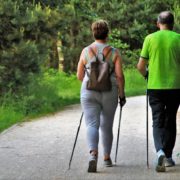Four Overlooked Reasons Your Knee Pain Won’t Go Away
If you’re one of the many people out there suffering from chronic knee pain – and wondering why it won’t just go away – you’re not alone.
Most of the folks I speak with in this situation have been told it’s simply due to arthritis, old age, or general wear and tear – and there isn’t much that can be done about it. First of all, that’s not true. But second – one of the biggest reasons people are led to believe that there’s nothing that can be done about their chronic knee pain is because they’ve tried just about every treatment out there – and nothing has worked.
What’s the biggest culprit for that? Almost always – it’s misdiagnosis. Meaning, something crucial was overlooked when it comes to the underlying reason for your knee pain (and structures in and around your knee joint get blamed instead).
Here are 5 of the most common overlooked reasons that can lead to misdiagnosis of your knee pain – causing it to linger and not go away:
1. You’re Focusing On Knee Strength Over Mobility
Focusing on knee strength and overlooking mobility is something I see far too often – and it’s a big reason knee pain lingers longer than it should. Mobility refers to the joint’s ability to move through its full range of motion, which is crucial for proper alignment and injury prevention. Without sufficient mobility, strength exercises can place undue stress on the knee, leading to compensations and pain.
When it comes to mobility, it’s important to compare right and left knees, as well as look at “hypermobility” – because it all matters. You want to make sure you’re optimizing mobility according to the person, and not a “textbook” definition. By improving and optimizing mobility in your knee first, you ensure that your knee can move freely and efficiently, reducing the risk of strains or overuse injuries when you begin to load the joint with strength training.
2. The Real Culprit Could Be Your Back
Did you know that 25% of the time – pain in your knee can come from a source in your lower back – even when you don’t have any back pain? Pain that moves around your knee, is challenging to pinpoint, or aches into your thigh or lower leg are all signs that your knee pain could actually be a back problem. Specialized movement screening of your lower back should be required for anyone suffering from any kind of knee pain – but it’s not.
Precautionary low back screening by a mechanical pain expert is rarely done – and it’s one of the biggest reasons I see for knee pain misdiagnosis. When knee pain is coming from your back – and you miss it – people not only suffer from knee pain longer than they should – but they risk being prescribed unnecessary cortisone shots, procedures, and surgeries in knees that never even had a problem to begin with.
If your knee pain isn’t going away and especially if the pain moves around – consider your lower back.
3. Your Knees Are Compensating For Weak Core Muscles
Your core – made up of four major muscle groups (your abdominals, lower back muscles, glutes, and hip muscles) plays a critical role in stabilizing your body, supporting proper posture, and distributing weight evenly during movement. When any part of your core is weak or not functioning optimally, your body will compensate by placing excess strain on other areas, such as your knees. Workload that is normally better handled and supported by say – your hips and glutes – will be taken over by your knees.
The result is increased stress in your knee joints and surrounding structures – which can lead to pain, inflammation, and even injury over time. Additionally, when you lack adequate core strength, your body lacks the stability needed to control movements efficiently, which can be another factor in forcing your knees to work harder than they should. If you’ve got lingering knee problems and never looked at strengthening your core properly – get started now. This could be one of the overlooked factors leading to a misdiagnosis of your knee problem and subsequent chronic knee pain.
4. Stiff Ankles Are Putting Stress on Your Knees
We already talked about how important it is to focus on knee mobility. But it’s equally important to focus on the mobility of joints above and below your knees, namely, your ankles. Ankle stiffness can be due to a number of factors – such as footwear, poorly rehabilitated injuries (like chronic ankle sprains), and repetitive/overuse activities that involve heavy use of your feet, ankles, and calves.
When your ankles are stiff, especially during activities like running, squatting, or even walking – your knees will compensate.
The result may not be noticeable right away – but over time – this extra compensation can result in unwanted knee pain. And if you never identify that the cause might be stiff, overused ankles – then you’ll continue to blame the irritated structures of your knee joint instead. If your ankles always feel tight, or your lower legs get fatigued frequently during repetitive movements, this could be a sign that your lingering knee pain is the result of compensation for stiff ankles. Improving ankle mobility might be the missing solution to freeing up your knees.
Chronic knee pain does not have to be something you accept – and it certainly doesn’t require a cortisone shot, procedure, or surgery to fix it. Most knee pain (at least 80%) can be resolved naturally. But it starts with the correct diagnosis. If you’ve been suffering from knee pain for a long time and feel like you’ve already tried everything – consider one of these four overlooked reasons. And to be sure – visit a mechanical knee pain specialist who can check all of these things out and give you an accurate diagnosis of your lingering knee pain.
Are you a local to Portsmouth, NH?
If so, CLICK HERE to speak to one of my specialists. They can help you discover effective strategies to finally relieve your knee pain and get back to doing what you love!
Dr. Carrie Jose, Physical Therapy Specialist and Mechanical Knee Pain Expert, owns CJ Physical Therapy & Pilates in Portsmouth and writes for Seacoast Media Group. To get in touch – or request a seat in her upcoming Masterclass to end Knee Pain naturally – without pills, procedures, or surgery – CLICK HERE.











